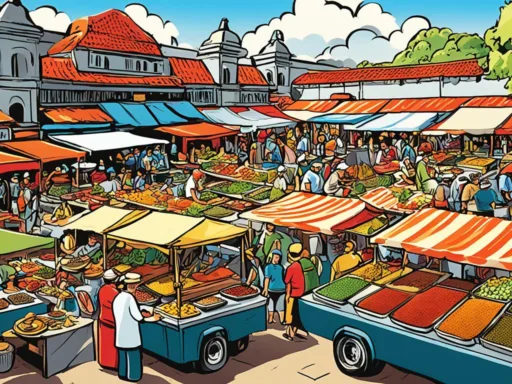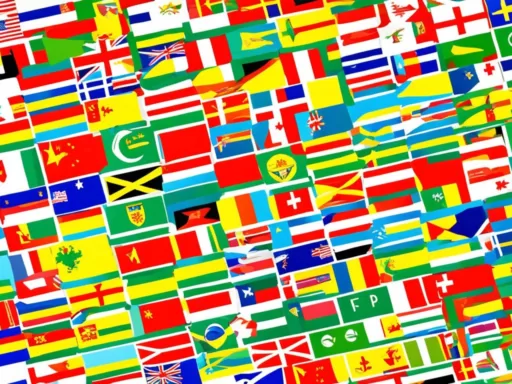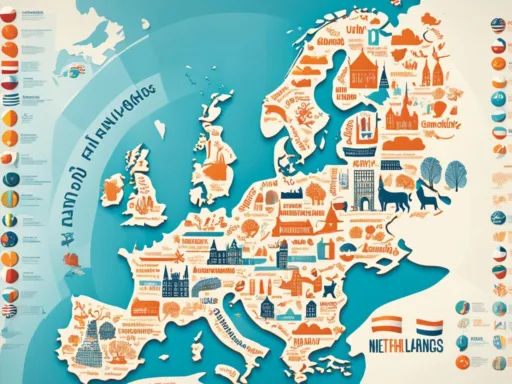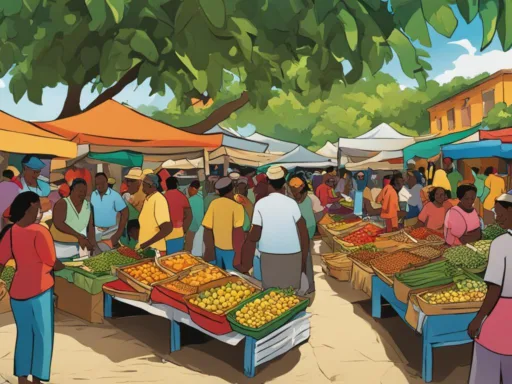At the heart of South America lies Guyana, a nation renowned not just for its lush, unspoiled landscapes, but also for its rich linguistic diversity. As the only English-speaking country in South America, Guyana presents a unique blend of Guyanese culture and colonial history within its linguistic realms. From the bustling markets of Georgetown to the serene expanses of the Rupununi savannahs, the languages spoken in Guyana serve as a testament to the nation’s vibrant multicultural heritage.
While English is the official language, facilitating government and business communications alike, it is the melodious sounds of Guyanese Creole, or Creolese, that fill the air in casual settings. This English-based creole language weaves together African, Indian, and Amerindian lexical threads, creating a linguistic mosaic reflective of the country’s diverse populace. Its widespread use showcases the adaptive nature of languages to encapsulate the spirit of a nation. Furthermore, within the Indo-Guyanese communities, languages like Guyanese Hindustani and Standard Hindi underscore the country’s cultural plurality, resonating through religious ceremonies and familial gatherings.
In the verdant hinterlands, the Amerindian languages—including Cariban and Arawakan tongues—continue to echo the ancestral voices of Guyana’s indigenous people. These languages, brimming with the wisdom of the ancients, are a crucial aspect of their identity and resilience. This linguistic kaleidoscope not only colors Guyana’s social fabric but also enriches the global tapestry of language and culture, inviting linguists, travelers, and cultural enthusiasts to explore and appreciate the symphony of sounds that is uniquely Guyanese.
Key Takeaways
- English is the official language of Guyana, an English-speaking country in South America with a storied colonial past.
- Guyanese Creole, an English-based creole language with diverse linguistic influences, plays a central role in daily communication.
- Indo-Guyanese languages such as Guyanese Hindustani and Standard Hindi are preserved for cultural and religious expression.
- Amerindian languages are vital to the cultural diversity and indigenous heritage of Guyana.
- The linguistic fabric of Guyana is a reflection of the country’s rich history and multifaceted Guyanese culture.
The Significance of English in Guyana
As the official language of Guyana, English plays a pivotal role in the nation’s communication infrastructure. From education to policymaking, English serves as the gateway to global discourse, cementing Guyana’s position in the international community. With a history shaped by British colonization, the use of English has become a cornerstone of Guyanese identity, mirroring the country’s commitment to multilingualism in a society enriched by language diversity.

English as the Official Language
Spanish and Portuguese trail behind English in the linguistic hierarchy of Guyana. Although English’s prevalence is undisputed, its reach has bred a culture of bilingualism, as these other languages gain traction in educational systems, reflecting Guyana’s versatile linguistic palette. English remains the indisputable linchpin of national administration, its resonance felt from government halls to classroom walls. This reality anchors Guyana’s linguistic nexus, with English at its core, harmonizing a tapestry of ethnic dialects and foreign tongues.
Historical Context and Modern Usage
Dating back to colonial times, English became ingrained in Guyanese culture, shaping legal, administrative, and academic frameworks. In contemporary Guyana, this heritage language continues to thrive alongside Creolese, not just as a remnant of the past but as a living, evolving medium. English’s adaptability has cemented it as a crucial element of Guyana’s socio-economic fabric, reinforcing its reputation as a society embracing multilingualism within a landscape of rich language diversity.
Languages Spoken in Guyana: A Glimpse at Guyanese Creole
Within the rich tapestry of Guyanese languages, the distinctive character of the Creole language in Guyana stands as a vibrant thread in the nation’s cultural fabric. More commonly referred to as Guyanese Creole or Creolese, this language encapsulates a unique blend of English with African, Indian, and Amerindian nuances, presenting features that are entirely its own. The result is a linguistic phenomenon that embodies the diversity of Guyana’s heritage and its ongoing narrative of cultural synthesis.

Origins and Characteristics of Guyanese Creole
Tracing its origins to the historical juncture of colonization and cultural plurality, Guyanese Creole has carved itself a distinct niche in linguistic study. Its sounds and structure diverge significantly from Standard English, reflecting the impact of various ethnic influences upon its formulation. This dynamic language exhibits a simplified grammar, and its phonetics are shaped by the melodic intonations reflective of its multicultural roots. As a spoken vernacular, it serves as a symbol of the collective experience and resilient spirit of the Guyanese people.
Societal Role and Linguistic Evolution
Guyanese Creole’s role extends beyond mere communication; it acts as the voice of cultural identity and community cohesion. Pervasive in music, storytelling, and within the privacy of home life, it resonates with the warmth of kinship and shared heritage. Over the years, as Guyana welcomed new languages and saw sociolinguistic shifts, Creolese adapted accordingly. Its continual evolution is testimony to the living nature of language, filtering through the generations, absorbing, and refracting the diverse lexicon of a people ever in flux.
- The phonetics of Guyanese Creole are influenced by its African, Indian, and Amerindian origins.
- Grammatically, it is distinct from Standard English and reflects simplified structures.
- Creolese carries a significant societal role, signifying a shared identity within the Guyanese community.
- The linguistic evolution of Creolese is a reflection of Guyana’s history and its societal changes.
Preservation of Amerindian Languages in Guyanese Culture

The rich tapestry of Guyana’s multicultural backdrop is nowhere more apparent than in the vibrant array of indigenous languages that pepper the nation’s soundscape. Among these, the Amerindian languages stand out as testaments of resilience and cultural complexity. Languages such as Macushi, Akawaio, Wai-Wai, Arawak (Lokono), and Wapishana not only survive but continue to flourish within diverse indigenous communities. Recognizing these languages not merely as means of communication but as repositories of age-old traditions, wisdom, and worldviews is key to understanding the very soul of Guyana’s rich identity.
An essential part of preserving the Amerindian languages of Guyana involves acknowledging their role in maintaining the cultural diversity and identity of indigenous populations. These languages, each with their own unique syntactic and lexical profiles, provide insights into the ingenuity and adaptability of human communication. Through storytelling, ritual, and the daily exchanges of community life, they carry forward the historical lineage and collective memories of an entire society.
In acknowledgment of their cultural significance, concerted efforts are underway to safeguard and promote these quintessential facets of Guyana’s heritage. The survival of indigenous languages in Guyana is paramount, ensuring the continuity of a way of life and a thought system intrinsic to the Amerindian communities. These preservation endeavors are not simply exercises in linguistic documentation but are fundamental to the enduring tapestry of Guyana’s social and cultural narrative.
These indigenous voices of Guyana are irreplaceable strands in the fabric of our nation’s identity, imbuing our collective consciousness with a profound sense of belonging and historical continuity.
- Macushi and Akawaio languages encapsulate the ecological knowledge of Guyana’s natural landscapes.
- Wai-Wai’s lexicon offers a window into the intricate social structures and beliefs of its speakers.
- Arawak (Lokono) carries the rich maritime history of coastal communities.
- Wapishana’s vocabulary harbors the secrets of the savannahs and its fauna.
While today’s technological and social shifts pose challenges to linguistic conservation, initiatives that immerse younger generations in the languages of their ancestors are helping to ignite a renewed interest and pride in this aspect of their identity. Language revitalization programs, educational resources, and community-led efforts underscore the value placed on these languages for the benefit of future generations.
As Guyana moves forward, balancing modernity with tradition, the dedication to protect the voices of its first peoples paves the way for a society that honors and takes pride in the multifaceted nature of its cultural expressions. Embracing the Amerindian languages of Guyana is tantamount to embracing a vital part of the nation’s soul.
Exploring the Diversity of Indo-Guyanese Languages
The Indo-Guyanese communities of Guyana present a fascinating linguistic tapestry, with languages rich in cultural and historical nuance. Among these, Guyanese Hindustani and Standard Hindi stand out as bastions of tradition, linking the Indo-Guyanese people to their South Asian roots. As we delve into the complexity of Indo-Guyanese languages, it is clear that they are more than mere tools for communication—they are treasured elements of cultural identity.

Guyanese Hindustani and its Variants
A derivative of Bhojpuri, Guyanese Hindustani venerates the past, primarily thriving in cultural and religious contexts. This linguistic variant is a nostalgic echo for many Indo-Guyanese, especially the elders, resonating in the hum of folk melodies and the intimate spaces of domestic life. Its preservation is emblematic of the community’s reverence for its ancestral heritage, equipping future generations with the lexical keys to unlock their cultural identity.
Standard Hindi: Religious and Cultural Significance
Standard Hindi occupies a place of reverence within the Hindu community, particularly illuminated in religious ceremonies where it resounds with sacred connotations. Maintained in written forms including texts and scripts, its presence in Guyana transcends spoken language and becomes a vessel for spiritual and cultural continuity. The significance of Standard Hindi among the Indo-Guyanese languages is profound, fostering a connection to the subcontinent’s spiritual ethos within the Guyanese mosaic.
Both Guyanese Hindustani and Standard Hindi offer invaluable insights into the Indo-Guyanese communities’ everlasting bond with their forebears’ traditions. In exploring the diversity of these languages, one uncovers the heart of Indo-Guyanese identity and the resilient threads that weave its rich cultural tapestry.
The Impact of Education on Multilingualism in Guyana
Education in Guyana serves as a catalyst in the country’s commitment to multilingualism and cultural richness. Through the incorporation of various languages into the educational framework, Guyana is nurturing a generation capable of thriving in a multi-lingual world. The language education policies of Guyana are specifically designed to expose students to a broad linguistic spectrum, thus fostering an environment of diversity and intellectual flexibility.

Spanish and Portuguese as Second Languages
With neighboring countries speaking predominantly Spanish and Portuguese, these languages have become an essential part of the curriculum in Guyana’s secondary schools. This strategic educational move not only enhances bilateral and regional relations but also opens up additional avenues for economic and cultural exchange. The introduction of Spanish and Portuguese positions students to take advantage of opportunities within the South American continent and beyond, perpetuating the ideals of multilingualism in Guyana.
Language Education and Policy
At its core, language education in Guyana is about more than just acquiring communication skills—it is about understanding and appreciating various worldviews and cultures. Guyanese education policy makers recognize the value of languages as tools for integration into the global community. The country’s emphasis on language diversity and language education underpins a broader policy objective of fostering a nuanced and well-rounded society. This policy is demonstrative of Guyana’s broad-ranging dedication to equipping its citizens for the ever-evolving demands of a connected, multicultural global landscape.
Guyanese Language Aids and Learning Resources
Navigating the linguistic diversity of Guyana is made easier with an array of language aids Guyana and learning resources Guyana have to offer. These tools are not only beneficial for those looking to dive into the complexities of regional dialects and official lingoes but also provide a platform for cultural exchange and understanding. Whether you’re a local student, a visiting linguist, or a curious traveler, these resources are gateways to enhancing communication and enriching experiences in this culturally vibrant country.
Dictionaries and Online Resources
For the linguaphiles and researchers among us, online dictionaries and platforms lay the groundwork for exploring the nuances of Guyana’s languages. York College’s Guyanese Creole resource site stands as a testament to the efforts made in documenting and educating the public about this expressive language. Equally, the availability of Guyanese Hindustani dictionaries in PDF format on various platforms ensures the preservation and accessibility of Indo-Guyanese linguistic heritage. Platforms such as Glosbe and Lexilogos are also indispensable tools, facilitating learners to delve into the intricacies of the language and grasp its cultural essence.
Language Learning for Travelers and Enthusiasts
Travelers and language enthusiasts, set on experiencing the rich tapestry of Guyana’s cultures, find a valuable ally in the realm of digital language learning tools. From Omniglot’s pronunciation guides to HindiPod101’s immersive content, aspirants of Standard Hindi can refine their communicative prowess. Whether it’s deepening one’s understanding of religious texts or enjoying Bollywood entertainment, these learning resources Guyana provides are a bridge to genuine cultural immersion. They are more than just educational tools—they are passports to connecting with the heart and soul of Guyana’s communities.
FAQ
What languages are spoken in Guyana?
Guyana is a linguistically diverse country where the official language is English. In addition to English, Guyanese Creole, which is based on English but influenced by African, Indian, and Amerindian dialects, is widely spoken. Various Amerindian languages such as Macushi, Akawaio, Wai-Wai, Arawak, and Wapishana are also prevalent. Indo-Guyanese languages, including Guyanese Hindustani (a form of Bhojpuri) and Standard Hindi, are used within the Indo-Guyanese community for cultural and religious purposes. Spanish and Portuguese have been growing as second languages in Guyana, enhancing its connection with the rest of South America.
Why is English the official language of Guyana?
English holds the status of the official language in Guyana due to the country’s history as a British colony. It remains the primary language used by the government, within the educational sector, and in legal contexts. English is also a unifying tool that bridges the diverse ethnic and linguistic groups in Guyanese society, facilitating communication and international engagement.
How does Guyanese Creole differ from Standard English?
Guyanese Creole, often referred to as Creolese, is a creole language that has evolved from English mixed with linguistic elements from African, Indian, and Amerindian languages. It features distinctive phonetics, grammar, and syntax that set it apart from Standard English. Creolese is central to Guyanese culture and is primarily used in informal communication and social settings.
What are the efforts being made to preserve Amerindian languages in Guyana?
There are various initiatives aimed at preserving the Amerindian languages in Guyana, including educational programs, cultural preservation projects, and the inclusion of these languages in some regional communication mediums. Recognizing the significance of these languages to indigenous identity and heritage, such efforts are crucial for maintaining the country’s linguistic diversity.
What is the cultural significance of Indo-Guyanese languages like Guyanese Hindustani and Standard Hindi?
Indo-Guyanese languages such as Guyanese Hindustani and Standard Hindi play a fundamental role in preserving the cultural heritage and identity of the Indo-Guyanese community. While Hindustani remains in use primarily within older generations for folk songs and cultural expressions, Standard Hindi is significant for religious observances and cultural rituals, acting as a link to ancestral traditions and contributing to the multicultural mosaic of Guyanese society.
How does the education system in Guyana promote multilingualism?
Guyana’s education system encourages multilingualism by incorporating the teaching of languages such as Spanish and Portuguese as part of the curriculum. The approach not only equips students to connect better with neighboring countries but also fosters a polyglot environment that is viewed as essential for the nation’s regional integration and economic development.
Where can I find resources to learn more about Guyanese languages?
For those interested in Guyanese languages, there are numerous resources available. Dictionaries and learning platforms for languages such as Guyanese Creole and Hindustani can be found online. Educational websites like York College’s Creole resource site, PDF dictionaries, and platforms such as Glosbe and Lexilogos provide valuable information for learners. For Standard Hindi, resources like Omniglot and HindiPod101 offer pronunciation guides and immersive learning content suitable for both travelers and language enthusiasts eager to engage with Guyana’s cultural diversity.






